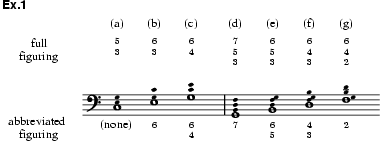
Like its equivalents bezifferter Bass, basse chiffrée, basso numerato etc., figured bass is a reference term for the bass part of an ensemble work, usually of the 17th or 18th centuries, furnished with figures and other signs telling the player the harmonies implied, stated or required above the bass; see also Continuo. It is not a term used for the function of the bass part, nor are the instrumental parts labelled thus; rather it reflects the later significance of continuo-playing as a didactic exercise. ‘Figured’ music in such a title as Lorenzo Penna: Li primi albori musicali per li principianti della musica figurata (Bologna, 1672) indicates figural music as opposed to plainsong; an early use of ‘figured’ or ‘numbered’ in the more literal sense occurs in Stanislao Mattei’s title for his treatise Practica d’accompagnamento sopra bassi numerati (Bologna, c1824–5). In short, the term figured bass and its equivalents in other languages are reference terms belonging not so much to the period of continuo playing as to the theorists, teachers and lexicographers of a later period who required a term to refer to the bass line itself. Earlier, however, C.P.E. Bach referred to bezifferter Bass as the instrumental part on which the keyboard player initiated in Generalbassstudien bases a feine Accompagnement or basso continuo. The term is not entirely satisfactory, since many early continuo parts are not figured, and very few (perhaps no) bass parts are figured completely from a theoretical point of view.
Conventions governing the use of figures vary considerably between repertories. As a general rule the principle of figuring is to notate only intervals over the bass note that deviate from the root position triad (5-3 chord): the figures 5 and 3 are therefore not normally written ( ex.1a). For instance, a chord with a 3rd, a 5th and a 7th is normally written as just 7 (ex.1d). The figure 6 normally replaces 5, and 4 or 2 replaces 3: the inversions of triads are therefore abbreviated as in exx.1b and c. Inversions of 7th chords have two factors a step apart (the root and the 7th) and the conventional abbreviated figuring reflects this (exx.1 e–g). Figures arranged horizontally show part movements, suspensions or appoggiaturas (98, 76, 43). Because the figure 2 normally replaces 3, the figure 9 is used in chords which also include the 3. Accidentals may be combined with any figures; an accidental on its own normally applies to the 3.

The complexity of figured-bass notation greatly increased after 1700. In 1711 Heinichen listed only 12 figurings; in 1728 this had risen to 32. The greatest number is probably the 120 listed by J.-J. Rousseau (1768). In Heinichen’s table of 1728 the upper division gives the usual abbreviated figuring and the two lower divisions give the other notes needed to form the chord. Abbreviated figurings removed from a bass context have commonly been used for harmonic analysis (for details of figuring conventions and the use of figures for analytical purposes, see Notation, §III, 4(viii).)
PETER WILLIAMS, DAVID LEDBETTER